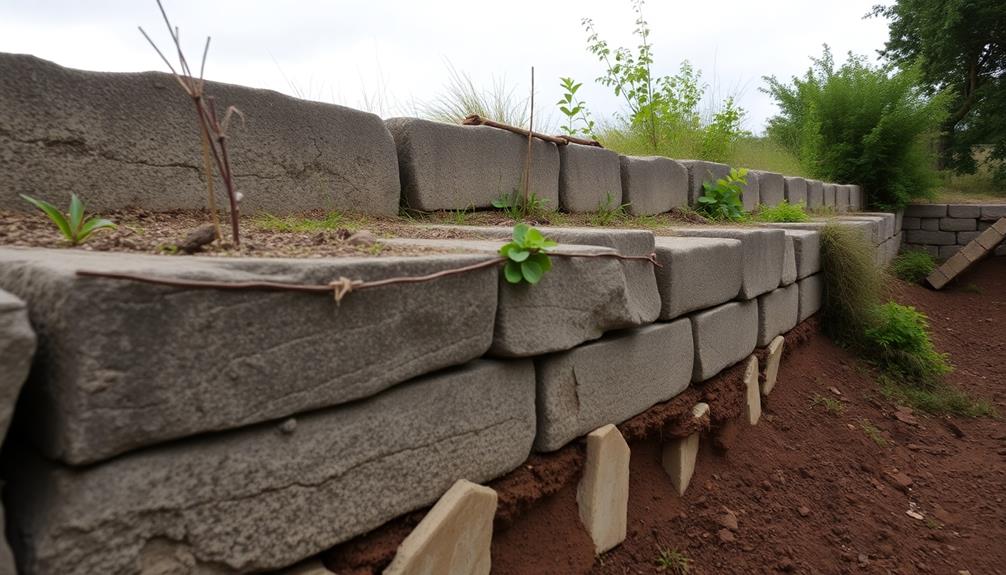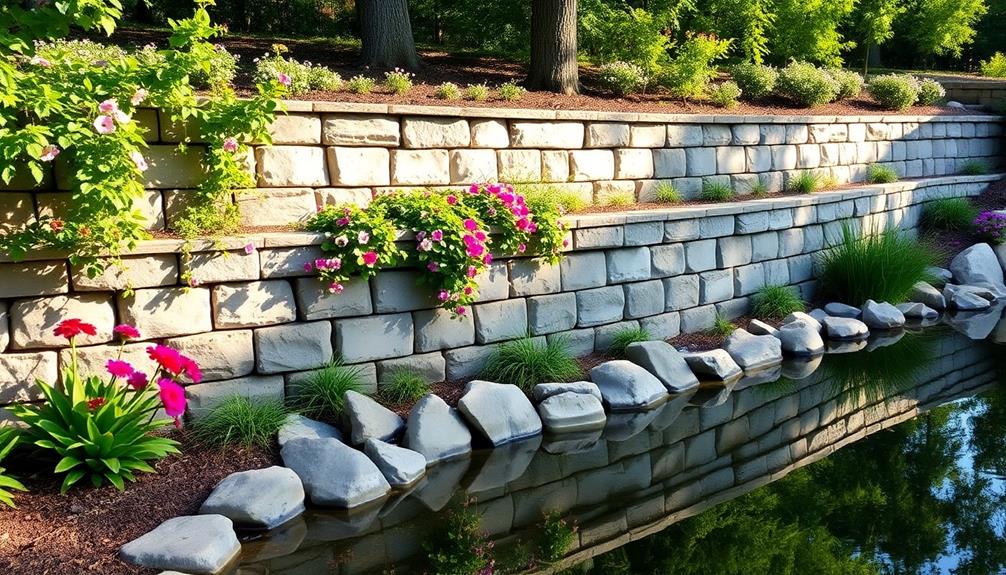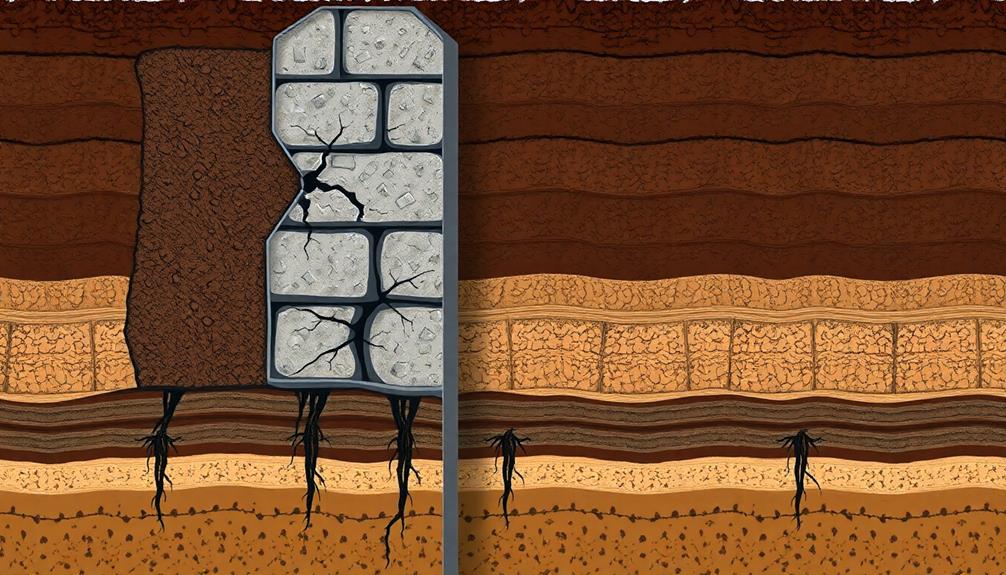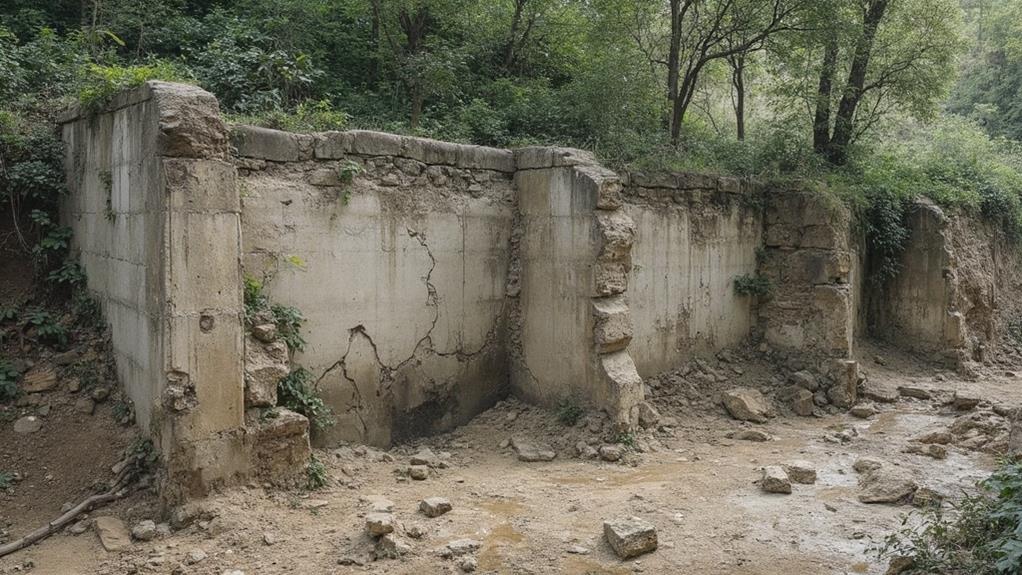Identifying common issues in retaining walls involves examining several critical factors. Visible cracks, whether vertical, horizontal, or stair-step, often signal structural weaknesses, possibly due to lateral earth pressure or thermal expansion. Displacement of the wall might indicate shifting from uneven settling or poor construction practices. Drainage problems manifest through water pooling or seepage, often revealing blocked weep holes or undersized drainage systems. Erosion signs such as soil displacement and sediment accumulation highlight inadequate maintenance. Additionally, soil instability caused by unsuitable conditions or insufficient support systems can lead to bulging or tilting walls. By understanding these symptoms, one can effectively address and prevent further complications.
Table of Contents
ToggleWalls Contractor Highlights
- Inspect for cracks, especially horizontal and vertical ones, as they indicate structural weaknesses in retaining walls.
- Evaluate drainage effectiveness by checking for water pooling and seepage through wall joints.
- Look for signs of soil erosion, such as soil displacement or sediment buildup near the wall.
- Monitor for structural instability signs, including bulging or shifting of wall sections from their original position.
- Regularly check for drainage pipe clogs and maintain proper drainage design to prevent water accumulation behind the wall.
Identifying Wall Issues Involves

Identifying issues in retaining walls requires a careful examination of visible cracks and displacement, which often indicate underlying stresses or foundational shifts that compromise the wall's integrity. Additionally, recognizing erosion on property or evaluating the creation of usable spaces can guide the assessment of any functional degradation over time.
Equally important is inspecting drainage problems and erosion, as inadequate water management can exacerbate structural weakness over time. In addition, attention must be paid to soil and structural instability, as these factors contribute to the overall safety and effectiveness of the retaining wall in maintaining its load-bearing responsibilities.
Visible Cracks and Displacement
The critical nature of a retaining wall's structural integrity becomes unmistakably apparent when visible cracks and displacement start to appear. Such indicators can signify underlying structural weaknesses and potentially exacerbate if left unaddressed.
Cracks, often appearing as vertical, horizontal, or stair-step formations, may reveal shifts in the wall's load-bearing capacity. These fissures occur due to various factors such as thermal expansion, uneven settling of foundation soil, or poor construction practices, each necessitating thorough examination.
Displacement, characterized by the movement or shifting of the retaining wall's original position, is another significant cue warranting immediate attention. This could manifest in slight tilting or bulging of the wall face, often tracing back to lateral earth pressures surpassing the wall's designed capacity.
Community well-being is fostered when such anomalies are identified early, enabling timely intervention. Engaging professional evaluations can mitigate progression toward severe structural failures, thus preserving the wall's functional role in landscape management and aesthetic contribution to communal spaces.
Members of a community responsible for maintaining such infrastructures should be proactive in seeking expert advice when these signs are identified, ensuring the structural cohesion and longevity of retaining walls essential to both public and private settings.
Drainage Problems and Erosion
Effective drainage systems and erosion protection are essential components in retaining wall maintenance and functionality. Without proper drainage, water can accumulate behind the wall, exerting additional pressure and leading to structural damage or failure. Signs of inadequate drainage include water pooling at the wall's base or seepage through its joints. These observations suggest the drainage mechanism—often a weep hole, drainpipe, or gravel backfill—is either blocked or undersized, necessitating professional assessment and rectification to prevent exacerbated wear on the wall.
Equally critical is addressing erosion, which undermines the wall's base and destabilizes its structure. Erosion is typically detected through soil displacement, diminished vegetative cover, or sediment accumulation in waterways below. Implementing landscape grading, vegetation, and geotextile fabrics can drastically reduce soil erosion by promoting stability and water absorption. It is imperative for property owners to routinely inspect and maintain both drainage and erosion prevention measures to guarantee the longevity of retaining walls.
Professionals in this sphere share a commitment to creating solid, lasting frameworks that safeguard against the natural elements. By emphasizing the importance of both drainage and erosion control, retaining wall integrity can be preserved, fostering a sense of shared responsibility and care within the community.
Soil and Structural Instability
Numerous factors contribute to soil and structural instability in retaining walls, necessitating a thorough evaluation to identify potential issues. A key aspect is the soil's condition and type, as these directly affect the wall's ability to endure pressure and maintain integrity. Unsuitable soil, such as loosely compacted or excessively moist ones, can lead to uneven settling or direct sliding, compromising stability. Identifying these traits is essential, ensuring that the chosen retaining wall design can sufficiently accommodate and withstand these conditions.
Structural integrity issues may arise from inadequacies during construction, including insufficient support systems or improperly installed tiebacks and deadmen, which provide necessary strength against lateral earth pressure. Observing the wall for signs such as visible cracks, bulges, or tilting assists in determining potential weak spots. Regular monitoring and maintenance help mitigate these risks, fostering longstanding resilience.
Moreover, external factors, including increased loads from nearby structures or changes in adjacent land use, can exacerbate instability. As a result, collaboration with geotechnical experts and engineers equipped with diagnostic tools becomes indispensable in addressing soil and structural concerns. This inclusive approach not only safeguards property but promotes a cohesive community environment, ultimately ensuring peace of mind for all stakeholders involved.
Benefits

Investing in a well-designed retaining wall offers numerous benefits that address both aesthetic and functional needs, including the assurance of structural integrity and the enhancement of a property's visual appeal. When constructed by collaborating with landscape architects and structural engineers, these walls not only contribute to increased property value by creating usable outdoor spaces but also play a critical role in improving soil stability, consequently preventing erosion and potential landscape damage.
Structural Integrity Assurance
Guaranteeing the structural integrity of retaining walls offers considerable benefits that extend beyond mere stability. A well-constructed retaining wall provides the foundation for improved safety, protecting those who move about in its vicinity from potential harm due to wall collapse. This structural assurance conveys reliability, an essential factor for individuals and communities aiming to foster an environment rooted in trust and security.
As a tangible expression of thoughtful planning and expertise, a structurally sound retaining wall not only upholds the land it supports but also fortifies the community's confidence in their built environments.
The assured strength of a retaining wall vastly limits maintenance requirements, translating into reduced long-term costs and increased convenience for property owners. By addressing potential weaknesses through initial structural considerations, stakeholders avoid future complications or unforeseen repairs as well as the disruptions that might accompany them. This attention to structural detail reflects a commitment not only to individual property stewardship but also to the collective well-being of the surrounding neighborhood.
Moreover, investment in the structural integrity of retaining walls signals a proactive approach to environmental responsibility. It guarantees the natural landscape's contours are respected, preserving stability in a manner that harmonizes human intervention with ecological balances.
Enhanced Aesthetic Appeal
A structurally sound retaining wall not only provides stability but also opens the door to enhanced aesthetic appeal. Constructed with quality materials and thoughtful design, these walls can transform a bland landscape into a masterpiece of functional beauty.
The choice of materials—ranging from traditional stone or brick to modern concrete designs—can complement your property's existing architecture, creating a seamless blend between natural and built environments. The design opportunities are endless, allowing homeowners to express their personal style while ensuring the landscape remains cohesive and engaging.
Incorporating elements such as lighting and greenery further accentuates the wall's visual appeal. Strategically placed lights can highlight textures and shapes, creating a dramatic effect during evening hours. Similarly, integrating plants or vines can soften the structure's appearance, fostering a feeling of tranquility and harmony with nature. This approach can also mask any minor visual imperfections, maintaining a pristine look.
Ultimately, a retaining wall's aesthetic qualities invite community admiration, fostering a sense of belonging and pride. By leveraging expert craftsmanship, these walls do more than retain soil; they offer an artful representation of your landscape vision, inviting others to connect and share in its enhanced beauty.
Increased Property Value
Enhancing curb appeal through the strategic addition of retaining walls considerably contributes to increased property value. The integration of these structures not only beautifies outdoor spaces but also demonstrates a commitment to maintaining the property, thereby attracting prospective buyers who value both form and function.
Retaining walls introduce a refined elegance that complements the landscape, offering potential buyers a vision of a well-cared-for property designed with an eye for aesthetic and practical balance.
Beyond mere visual appeal, retaining walls can transform the usability of sloped areas, creating additional flat spaces that are both functional and attractive. This expansion of usable land translates into tangible benefits for the homeowner, providing new design opportunities for gardens, patios, or recreational areas. Buyers are likely to be impressed by the expanded possibilities afforded by these modifications, perceiving them as enhancements that justify a higher investment.
Additionally, well-constructed retaining walls signal durability and foresight, suggesting that the homeowner has invested wisely in the property's long-term health. This perception of enhanced property management and stewardship can lead to a significant uplift in the market value, offering a compelling reason for potential buyers to evaluate the property as a worthwhile investment.
Improved Soil Stability
Beyond enhancing property value, retaining walls offer significant benefits with respect to soil stability. Recognizing these advantages is crucial for those seeking to bolster the integrity of their landscapes. Retaining walls act as a barrier to soil erosion, a natural yet detrimental process that can compromise land usability and safety. By mitigating erosion, these structures preserve soil structure and retain nutrients essential for any vegetation present.
Additionally, retaining walls provide a substantial load-bearing capacity that accommodates changes in topography, maintaining equilibrium in terrains characterized by uneven slopes. This is particularly important in areas prone to heavy rainfall or seismic activity, where shifting soil can pose substantial risks.
Retaining walls can also effectively redistribute lateral earth pressure, guaranteeing stability in areas with significant landforms. Here are some specific benefits to understand:
- Reduced risk of erosion: Retaining walls prevent the movement of earth, safeguarding against landscape degradation.
- Enhanced moisture control: By mitigating water runoff, they help retain essential moisture levels in the soil.
- Maintenance of soil consistency: They contribute to the equilibrium and uniformity of the soil's physical properties.
- Improved landscape usability: By supporting varying elevations, they allow for more creative and sustainable land-use planning.
Aptly constructed retaining walls thus ascertain long-term benefits in both functional and ecological contexts.
Soil Pressure Increases Problems

The increase in soil pressure is a critical factor that contributes to various structural problems in retaining walls, manifesting in clear signs such as excessive bulging, noticeable cracks, and alarming shifts in the wall structure. This elevation in pressure can be attributed to factors such as poor water drainage and the type of soil, which exacerbate the stress on these support structures, ultimately compromising their integrity. Below is a table summarizing the typical indicators of soil pressure-related issues in retaining walls:
| Indicator | Potential Cause | Effect on Retaining Wall |
|---|---|---|
| Excessive Bulging | Soil Saturation | Weakening of structure |
| Cracks | Soil Erosion | Compromise of wall integrity |
| Wall Shifts | Poor Foundation | Instability and leaning |
Recognizing these symptoms and their underlying causes is essential for taking preemptive measures to guarantee the long-term viability of retaining walls.
Signs of Excessive Bulging
Excessive bulging in retaining walls is a critical sign that soil pressure has increased beyond manageable levels, posing significant risks to structural integrity. This phenomenon commonly occurs when there is inadequate drainage behind the wall, leading to hydrostatic pressure that exacerbates the load the structure must bear. Such pressure can be catalyzed by saturated soil conditions, poor construction practices, or unexpected additions to nearby load-bearing activities. As a community dedicated to ensuring the longevity and safety of these structures, it is indispensable that members recognize the symptoms of this potentially dangerous condition.
Identifying excessive bulging involves observing several key indicators:
- Outward Bending: Sections of the wall may visibly curve away from the soil, demonstrating stress.
- Discoloration or Staining: Water seepage can lead to distinct marks on the surface, signaling trapped moisture.
- Consistent Water Accumulation: Pooled water near the base might indicate inadequate drainage causing pressure.
- Increased Leaning: The wall may visibly tilt forward, suggesting a shift in stability due to subterranean forces.
Cracks and Wall Shifts
Cracks and wall shifts serve as unmistakable indicators of soil pressure problems undermining retaining wall stability. These symptoms emerge when the force exerted by the soil exceeds the wall's designed capacity to withstand it, often due to changes in soil composition, such as an increase in moisture content causing soil expansion and increased weight. As pressure intensifies, it pushes against the retaining wall, leading to cosmetic and structural damage.
Observing patterns in the cracks can reveal their underlying causes: horizontal cracks suggest lateral pressure from the soil, vertical cracks may indicate differential settling, while diagonal cracks might point to uneven pressure distribution. Additionally, wall shifts—where sections of the wall move from their original placement—signal more severe instability and risk further escalation if not promptly addressed.
To maintain a sense of community resilience, it is imperative to recognize these signs early. Understanding the geological and physical forces at play allows for the informed selection of appropriate solutions, such as reinforcing the wall structure or employing soil stabilization techniques. This knowledge empowers property owners and communities to preemptively tackle these challenges, ensuring both safety and structural integrity in their shared environments.
Water Drainage Challenges
Ineffective water drainage poses significant challenges to retaining wall stability, primarily through the escalation of soil pressure. When water accumulates behind a retaining wall, it exponentially increases the lateral earth pressure exerted on the structure, subsequently leading to potential failure. This accumulation of water not only compromises the integrity of construction materials but also destabilizes the foundational support, essential for the wall's longevity and durability. In this manner, understanding and addressing water drainage challenges becomes paramount for property owners and engineers alike.
Key drainage challenges include:
- Clogged Drainage Pipes: Over time, sediment and debris can obstruct drainage systems, hindering water flow and exacerbating pressure against the wall.
- Insufficient Drainage Design: Poorly designed or inadequately installed drainage solutions that fail to account for site-specific conditions can lead to significant water retention and pressure issues.
- Inadequate Maintenance: Regular inspections and upkeep of drainage systems are critical, as neglect can result in unseen clogs or leaks, compounding water retention risks.
- Natural Soil Characteristics: Certain soil types, such as clay, are particularly problematic due to their low permeability, which can intensify water retention issues and escalate pressure on retaining walls.
Addressing these drainage concerns not only protects structural investments but fosters a sense of well-being within a cohesive community dedicated to sustainable living environments.
Walls Contractor FAQ
What Materials Are Best for Long-Lasting Retaining Walls?
For enduring retaining walls, consider using reinforced concrete, natural stone, interlocking concrete blocks, or treated timber. These materials offer durability and aesthetic appeal, fostering a sense of belonging within the landscape, while ensuring structural integrity and longevity.
How Often Should a Retaining Wall Be Inspected?
Retaining walls should be inspected annually to guarantee their integrity and longevity. This regular maintenance fosters community safety and aesthetic cohesion, allowing neighborhoods to thrive while preserving shared environments and preventing costly repairs or environmental hazards over time.
Can Planting Vegetation Affect the Stability of Retaining Walls?
Planting vegetation can indeed affect the stability of retaining walls. While certain plants help stabilize soil, inappropriate species may cause damage through root expansion. Consulting with landscape professionals guarantees a harmonious integration that enhances both stability and aesthetic appeal.
What Costs Are Associated With Repairing a Damaged Retaining Wall?
Repairing a damaged retaining wall can involve significant expenses, including professional labor, materials like reinforcements or replacements, and potential landscape restoration. Costs vary based on severity and location, fostering communal support and collaboration within property maintenance endeavors.
Are There Any Warning Signs Specific to Different Types of Retaining Walls?
Yes, different types of retaining walls exhibit distinctive warning signs. For instance, timber walls often show rot or insect damage, masonry walls might develop cracks, while concrete walls could lean or bow, indicating compromised structural integrity.







